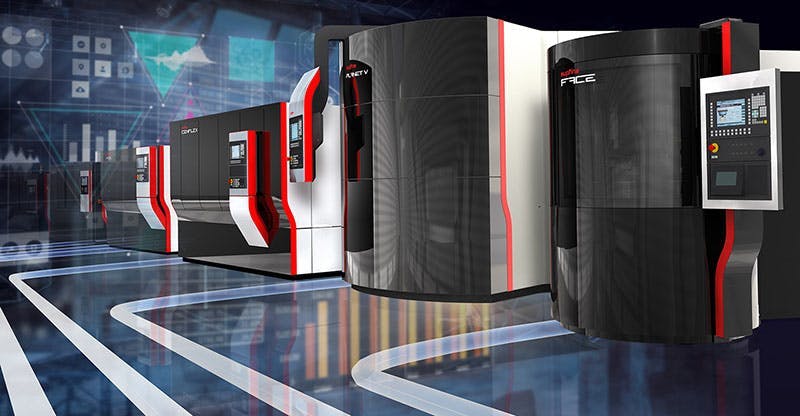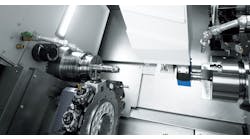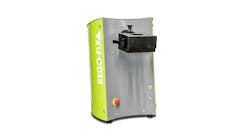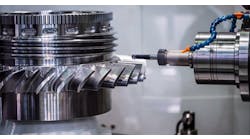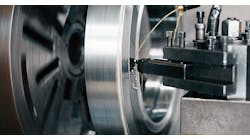Automotive design, and thus automotive manufacturing, is increasingly a function of regulations, or proposed regulations. In the European Union, the Euro 7 emissions program that are due to take effect in 2025 are having a notable influence on brake disc production: the pending standard aims to cut particulate emissions from automotive brakes (and tires) – 27% lower than the current Euro 6 standard by 2035.
One way to cut particulates is to apply harder surface coatings – laser deposition is emerging as a preferred process – which may reduce abrasion and thereby emissions by as much as 90 percent.
However, these brake discs present particular challenges for the high-volume grinding operation that must follow casting and coating. And this entire circumstance is creating a “stress test” for vehicle and component designers, brake disc manufacturers, and manufacturing technology developers and suppliers.
The considerable pressure imposed by the schedule for Euro 7 implementation is making it important to ensure that the process design and the resulting development partnerships are effectively coordinated.
At the ‘Schleiftagung’ (Grinding Conference) organized by the German Academic Association for Production Technology (WGP) in Stuttgart-Fellbach, Germany, earlier this year, Prof. Eckart Uhlmann from the Institute of Machine Tools and Factory Management IWF at TU Berlin emphasized the impact of the energy and mobility transition on production and manufacturing technologies – including grinding.
Components such as electric motors, low-emission brake systems and high-efficiency, low-noise gearboxes in electric vehicles must be manufactured in a way that is timely, efficient, and quality-compliant: Uhlmann warned that this can only succeed if the full potential of grinding technology is pursued. And hard-coated brake disks are a good example of this.
(VDW – the German Machine Tool Builders' Assn. has scheduled more discussion of Hard Coating at its GrindingHub event, May 14-17, 2024, in Stuttgart.)
New materials increase complexity
Jannik Röttger explained the challenges involved in machining hard-coated brake discs. Until recently researcher at RWTH Aachen University, is now the head of Grinding Technology at EMAG Maschinenfabrik:
"Put simply, what hard-coated brake discs do in the grinding machine is exactly the same as what they do in a low-emission vehicle – create a powerful braking effect with no loss of material," Röttger said. "However, we need to achieve the exact opposite in the grinding process. The aim is to remove material in the shortest possible time, in order to create the required geometry and surface properties."
He further explained that the hard coating consists of a relatively soft matrix, with carbides serving as the hard material. Both materials have fundamentally different machining properties. As a rule, grinding tools are optimized for either one or the other material behavior. The new material makes developing suitable grinding disks a major challenge. It is very complex to design the static and dynamic machine properties and the spindle drives due to the process forces involved.
Furthermore, it is not only the volumetric composition of the hard material and matrix that influences the machining properties of the hard material layer, but also the coating process. For laser deposition welding, for example, Röttger cited process parameters such as laser power and relative speeds. The thermal energy of the laser could cause the brake disk to distort. This must be considered in the subsequent grinding process.
For this reason, the entire process chain after the casting of the unmachined part – i.e. turning, laser coating, and grinding, as well as the resulting functional properties in the vehicle – must be considered and optimized as an overall system.
The entire processing chain
EMAG offers manufacturing solutions for each link in the machining chain that follows the casting process. This allows it to assess the specific interactions between the different manufacturing processes on its own turning, laser and grinding machines.
According to Röttger, EMAG designers, production engineers, and materials scientists, working with experts from RWTH Aachen University and coating system developers from HPL Technology, take an interdisciplinary approach to research and development so as to understand how to set machining parameters, and what are their results.
Michael Wöhrle, who heads R&D at Supfina Grieshaber, a superfinishing technology developer, is also convinced of the benefits of interdisciplinary and cross-company collaboration. The company started developing processes for grinding hard-coated brake discs four years ago. "From the outset, we have felt that close cooperation with our development partners is the only way to meet the EU’s Euro 7 requirements within the required timeframe," according Wöhrle. "We had to feel our way into the process – see what the powder manufacturers could bring to the table, for example, consider what the different coating processes involve, and ultimately decide what is realistic and what can be ruled out because it is simply too expensive for the mass market."
Supfina is not ruling out any technologies but is focusing primarily on laser deposition welding and the cold spray process. "We’re seeing an unprecedented pace of innovation," Wöhrle said. However, the uncertainty over the schedule and scope of the Euro 7 regime has been difficult to coordinate with the ongoing research.
Nevertheless, Wöhrle considers the reduction of particulate matter pollution to be necessary, and he concedes that, "without the new regulations, we wouldn't be as far along as we are now."
Double-sided grinding
Almost 100 million brake discs are produced in Europe every year; around half of these are for vehicle manufacturers and the rest for aftermarket parts. Experts assume that the vehicle industry will need to invest billions to produce brake disks that will reduce fine-dust emission levels. "Until recently, some brake discs were so cheap that they were sold by the metric ton," Supfina’s Wöhrle noted. "Expensive raw materials and processes have now been added to the mix, and with them the challenge of developing a product suitable for the mass market."
Double-sided grinding is favored by machine manufacturers because, according to Wöhrle, it guarantees simultaneous machining of both friction ring surfaces, high throughput rates, and short cycle times.
Supfina recently unveiled the Planet BD double-side grinding machine specifically for high-volume grinding of brake discs, and already it has been adopted by a number of well-known customers.
It’s a machine that will also be effective at machining brake discs for the emerging volume of electric vehicles. While brakes are applied far less frequently in EVs, and with less force because the recuperation of the motor often provides sufficient braking power. Still, this circumstance introduces a risk that "underused" brake systems may begin to rust, especially in wet weather conditions.
Coated brake discs can help address this problem, too, and Wöhrle is confident that the coating can be adapted to EVs’ slightly lower requirements of braking performance and number of braking cycles. The volume of expensive elements in the coatings can be reduced or replaced, making the process more cost-effective but with slightly reduced performance.
The experience gained in passing the Euro 7 stress test will ensure that the grinding experts are well prepared to achieve this.
Cornelia Gewiehs is a writer specializing in manufacturing technology.


